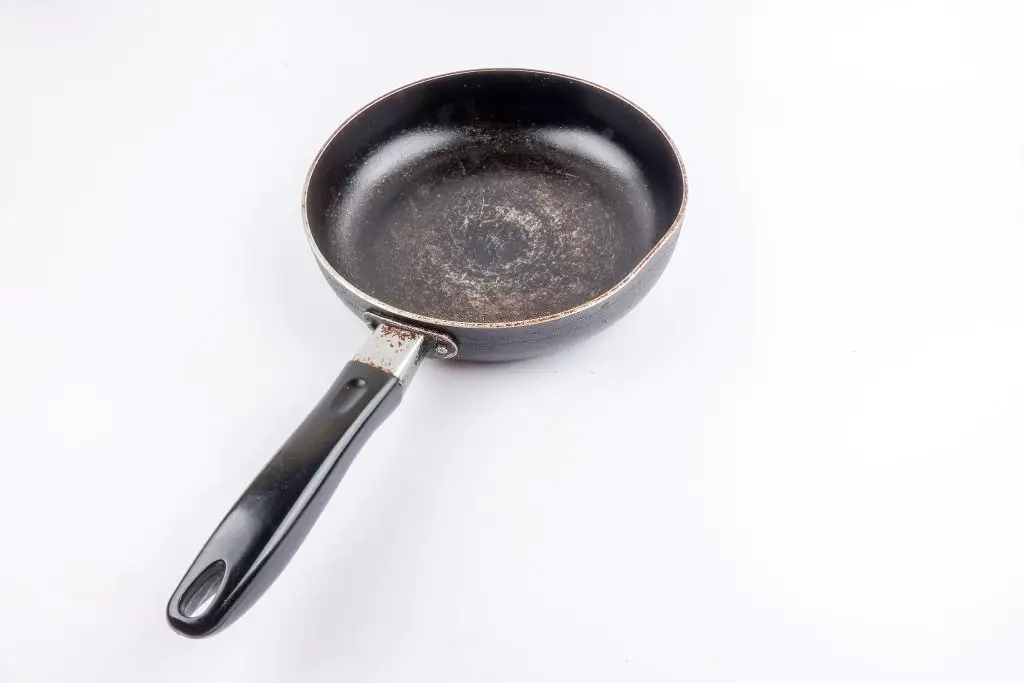How do you know when to throw away a cast iron skillet? When you start seeing visible scratches on the surface, If it is warped, cracked, and is corroding, then the chances are clear that your cast-iron skillet need to be replaced.
Cast iron skillet is the perfect kitchen utensil to cook on because it heats up fast and retains heat well.
However, over time, the seasoning or patina can start to wear off and your food will stick to the pan. There are also other signs that we are going to look into in this article.
We’ll be discussing factors that can affect the life span of a cast-iron skillet and the right time to throw it away.
Contents
When to Throw Away a Cast Iron Skillet

Throw away your cast-iron skillet, when you start noticing serious indications that appear on the body of the cast-iron skillet due to the following reasons.
- Excessive heat exposure without adding ingredients
- Seasoning the surfaces with acidic food
- Using metal utensils
- And total negligence.
Cooking in a cast-iron pan can be very dangerous to health if it is not properly maintained. Your food will be contaminated, so if your cast-iron is not able to perform up to standard throw it away and get a new one.
Let’s take a closer look at 6 circumstances why you should throw away a cast-iron skillet.
Read: Skillet You Can Put In The Oven
6 major factors why you should throw away your cast-iron skillet
1. When Cast-Iron Skillet Is Chipped
When Cooking food with high heat for long period of time. If you are not very careful, you can burn the food.
The process of scraping the surface to remove stuck food particles may result in chipping the cast-iron skillet.
If this is repeated, you can expect to see more, which will damage your pan irreparably. If you continue to use it, you will only bring yourself more harm than good.
2. When Cast-Iron Skillet Becomes Wobbly
When a cast-iron skillet is not properly maintained and taken care of, you will notice that the more you continue to use the more it warps and becomes wobbly as a result of heat expansion.
If your cast iron skillet is wobbly enough that it is unsafe to use, throw it away and get a new one.
3. When Holes Start Forming at the Bottom of Cast-Iron Skillet
This happens when cast-Iron skillet has been exposed to harsh washing techniques, long term of using metal utensils, and improper care. This will lead to a hole forming at the bottom of the cast-iron skillet.
If this happens, then it’s time to throw away your cast iron skillet and get a new one.
4. When Cast-Iron Skillet Cracks
A cracked cast iron skillet is not safe to use. It can lead to the spread of bacteria into your food, which is unhealthy. The cracks can be very dangerous, even the smallest cracks can further expand under heat.
When you start seeing a sign of this tear, just know it’s time for a new one.
5. When Cast-Iron Skillet Starts to Rust
What can cause cast iron skillet to rust? Lack of proper cleaning and storage over time can cause the cast-iron skillet to rust. You’ll notice the metal will start to rust or corrode.
When moisture keeps seeping into the pores of the cast-iron skillet, it will start to flake off in chunks. When a cast-iron skillet corrodes it becomes unusable to use and needs to be thrown away.
6. The Age of Cast-Iron Skillet
When the quality of the original material of the cast iron skillet is below standard, combined with lack of seasoning your cast iron skillet will affect the lifespan of the cast-iron skillet.
Read: Black Residue In Cast Iron Skillet
Conclusion
There comes a time when a cast iron skillet should no longer be used. The factors mentioned above should be easy enough to inspire you to know when to throw away cast iron skillet.
A good quality cast iron skillet that is well used and properly cared for can last for a long time.
